#they are one of the few predators of the crown of thorns starfish
Text
The Reef and the Deep


For @buginateacup's fic Haute Water, in which the trio goes to the Met Gala in Minion's designs. These were so much fun! I learned a lot!
Image descriptions: Roxanne and Minion and Megamind in extremely fancy outfits.
Roxanne's dress is cut sharply up the thigh and looks like a wave rolling in - sleeveless, strapless, it has a bustled train of tulle scattered with seed pearls and a waist gather with a seashell and corals. The top of the bodice also has the same seafoam tulle, which wraps around Roxanne's arms. She is wearing a necklace and crown of coral and has iridescent blue highlights on her face. She is holding Minion aloft in a net of pearls. Minion looks extremely pleased with himself and is wearing pink eyeshadow.
Megamind is wearing ink-black and very sharp fins on his ears, a net of black pearls on his head. He has spines of very dark blue rising from his shoulders and arms, and similar spines falling in a narrow overskirt from his waist. He has lionfish-fin spines framing the sides of his cape, which is very dark blue inside and black outside. He has no shirt, but is wearing fishnet sleeves with scattered black pearls, and black armor on the backs of his hands and fingers. His boots are laced all the way up his thighs.
Both are on a pinkish-lavender background with a faded splash effect behind them.
#megamind#megamind fanart#megamind fanfic#please stroke my ego lol these are by far the most ambitious pieces i've ever attempted#updated to add image descriptions#dal is a fanart#dal draws#megamind rules#megamind vs the doom syndicate#the seashell is a Triton's trumpet#Charonia tritonis#they are one of the few predators of the crown of thorns starfish#which is becoming a major problem on the great barrier reef#these snails can reach up to two feet in length and have pretty stripy eyestalks#and a lovely mottled body#met gala
69 notes
·
View notes
Text
Ocean Animal of the Week.
Today is an important day.
Today marks the birth anniversary of a fictional man who is very dear to my abyssal heart. I will not explain who it is. You will all simply have to find out for yourselves.
One of the creatures I find myself associating with him is the Crown of Thorns Starfish.
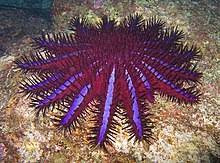
What majestic creatures!
Crown of Thorns Starfish (or Sea Stars) are born of the order Valvatida, and the family Acanthasteridae.
They were given their names based on the venomous spines that coat their bodies. Their spines are very toxic to humans and other animals, but not all are weak to its poison. Creatures such as the giant Triton snail, Humphead Maori Wrasse, and Titan Triggerfish are a few of this creature's natural predators.
This starfish's diet consists primarily of coral, and they can have devastating effects on coral reef ecosystems.
These creatures can release millions of eggs. Many sea stars are known for having extremely large clutches.
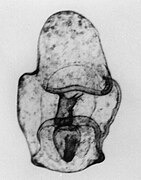
This is a starfish in its bipinnial larva stage. Look how adorable their baby photos are. Don't you just want to pinch its cheeks?
Some starfish reproduce through both sexual reproduction and asexual reproduction, their asexuality being shown through binary fission and regeneration. These dual reproduction methods classifies those starfish as bisexual. Good for them.
Strangely, unlike those other starfish, these specific sea stars are not known to reproduce asexually, and instead often reproduce by releasing their gametes into the open water and waiting for them to be fertilized.
Other facts:
-If you so happen to be "stung" by this starfish, the symptoms may include redness and swelling. In more severe reactions, there may be tingling, numbness, weakness, nausea and/or vomiting, joint aches and headaches, and in more serious and rare cases, paralysis.
-They can kill off entire coral colonies from how voracious they can be.
-There is a pokemon based on them! Mareanie and Toxapex are reportedly based on these starfish, and you can clearly see the resemblance in their spines.
-They prefer to eat branching corals and table-like corals. They have good taste.
-If hard corals are scarce, they may potentially feed on soft corals.
-They can have around 21 arms!
-They are one of the biggest starfish species in the world, but are still smaller than starfish such as the Sunflower Starfish. The Sunflower Starfish is reportedly 1 m/3.3 feet, while the Crown of Thorns Starfish reaches 45 cm.
-Sea stars and Starfish are technically the same thing, just beneath a different name. Some call these creatures "Sea Stars" instead of "Starfish", considering they don't classify beneath the term of "fish".
-They are very cute. :]
These creatures may be harmful to coral reefs, and that is a large concern.. But they are still a majestic species! Their beauty is indescribable, and they will always hold a special place in my heart!
Happy birthday to.. The man who i will not explicitly name.
#ocean#sea creatures#sea star#sea life#starfish#marine life#i consider them adorable.#they may be a danger to coral environments and extremely toxic...#but they are still adorable.
2 notes
·
View notes
Text
Napoleon Wrasse Production and Trade: Insights from Bohol, Philippines

Abstract
Market survey of Napoleon wrasse is needed to gather and analyze the data of this species in the market. Napoleon wrasse (Cheilinus undulatus) locally known as “Mameng” is a small but significant component in fish trading. This study was conducted to determine the prevalence of Napoleon wrasse trading through market surveys in the selected municipalities of Bohol namely the municipality of Calape, Getafe, and Tubigon, as basis for conservation measures. Descriptive survey method was used in the study. A one month survey was done to the three municipalities, where the survey took place only every market days. Results showed that the volume of production of Napoleon wrasse in the three municipalities was very low, where the total volume of production of Napoleon wrasse during the one month survey was 1kg in the municipality of Calape, 3.5kg in the municipality of Getafe, and 7kg in the municipality of Tubigon. Most of the fish vendors in the three selected municipalities of Bohol can rarely sell Napoleon wrasse. The volume of consumption of Napoleon wrasse in the three municipalities during the one month survey was relatively high where all of the Napoleon wrasse the fish vendors were selling was sold and sought by buyers. The volume of production of Napoleon wrasse in the three selected municipalities of Bohol was very low due its rarity resulting to its high demand and consumption rate. Among of the three municipalities, only the municipality of Getafe had been identified to have the prevalence of Napoleon wrasse trading.

Introduction
The Napoleon wrasse (Cheilinus undulatus), locally known as “Mameng”, is one of the largest of all reef fishes and the biggest of the wrasse family, the Labridae. It can reach well over two meters in length and 200 kilograms in weight. This species is considered a gourmet food fish and is appreciated for the fine taste and texture of its flesh and it has become a small but significant component of the live reef food fish trade for it is one of the most highly valued species in the trade (Sadovy et al., 2003)
Napoleon wrasse has thick lips and a prominent bulbous hump on the forehead. The juveniles of this species can be identified by their pale greenish color and two black lines running behind the eye. Napoleon wrasse lives on lagoon reefs and steep outer reef slopes at depths of 1 to 60 meters, temperature of 25.71 to 28.98 and salinity of 34.38 to 35.31 ppt. Its primary foods are mollusks, fishes, sea urchins, crustaceans and other invertebrates. Napoleon wrasse is one of the few predators of toxic animals such as sea hares, box fishes and crown-of-thorns Starfish (Randall, Allen and Steen 1990). The longevity of this species is up to at least 32 years and sexual maturity is reached at about eight years of age, meaning they are extremely slow are extremely slow hermaphrodites, which means they can start their life as a female and then change to the male, with sex reversal occurring at about 15 years of age.
Because of its high value as food, it is heavily sought by fishers and traders. There is now a considerable concern that this widespread but uncommon species is being threatened that cause decline of its number because of the growing demand of this species in the live reef food fish trade. International Union for Conservation of Nature (IUCN) stated that the Napoleon wrasse is primarily taken for export as part of the valuable live reef food fish trade which is centered in Southeast Asia especially from Indonesia, Malaysia, and including the Philippines. As part of the live food fish market of these countries, Napoleon wrasse value is likely to increase with rarity, so fishers will continue to fish this species even as its numbers decline. Buyers of this fish also continually have to source new areas as numbers of this species decline in the particular area where they can buy this Napoleon fish. The rampant trading of Napoleon wrasse was happening elsewhere, so there is a need of conducting a research study regarding on the prevalence of Napoleon wrasse trading in the three municipalities of Calape, Getafe, and Tubigon through market surveys. A market survey is a process of gathering and analyzing data of a certain product in the market.
To gather and analyze data of Napoleon wrasse in the market, a market survey was conducted in order to better understand the status of this species in the market. There are no data on total numbers of this fish globally. However, adults reef area within its distribution and even in preferred habitats; densities are very low for a commercially exploited species (rarely > 10 fish per 10,000 square meter when not fished). It is considered uncommon to rare naturally. Nothing is known about the extent of subpopulations or degree of fragmentation but available suitable habitat is a major determinant of its distribution.
Moreover, Napoleon wrasse trade in Malaysia and found that there is extensive, illegal, unrecorded and unmonitored Napoleon wrasse trading occurring between Malaysia and the Philippines. They found that although the Philippines banned the export of all live fish, “the government of Malaysia is aware and has admitted that most of the Napoleon wrasse stock exported from Sabah in Malaysia is caught in the Philippines. There appears to be no monitoring or records kept of the trade of Napoleon wrasse between the Philippines and Sabah. The Napoleon wrasse’s inclusion in the list of Convention on International Trade in Endangered Species (CITES) Appendix II in the year 2004, with the listing, international trade is only permitted if the export will not be detrimental to the survival of the species in the wild has been unsuccessful in protecting the species from further decline. For example, the wrasse trade in the Malaysia is regulated, in part, by CITES and pursuant to this convention. CITES permits are required before one can export wrasse. Chen and Justin found that prior to 2007 there was only one record of an export of two live wrasse (Chen and Justin, 2009.
In Philippines, exports of the Napoleon wrasse are prohibited throughout the country. Until recently, the Napoleon wrasse could not be exported from Palawan with an exemption for the taking of small fish for mariculture (Philippines Fisheries Code, 1998).
Fishing through explosives noxious or poisonous substance, and / or electricity its shall be unlawful for any person to catch, take or gather or cause to be caught, taken or gathered, fish or any fishery species in Philippines waters with the use of electricity, explosives, noxious or poisonous substance such as sodium cyanide in the Philippines fishery areas which will kill, stupefy, disable or render unconscious fish or fishery species. Provided, that the Department, subject to such safeguards and conditions deemed necessary and endorsement from the concerned LGU’s may allow, for research, educational or scientific purposes only, take or gather fish or fishery species. Provide, further, that the use of poisonous or noxious substance to eradicate predators in fishponds in accordance with accepted scientific practices and grounds shall not be construed as illegal fishing (Philippine Fisheries Code, Section 88).
Market survey on Napoleon wrasse is described as the systematic and objective identification, collection analysis, and dissemination of information for the purpose of assisting management in decision making related to the identification and solution of the problems pertaining to this species. That is, to provide management with relevant, accurate, reliable, valid, and current information.
Source : Napoleon Wrasse Production and Trade: Insights from Bohol, Philippines | InformativeBD
1 note
·
View note
Text
So today while playing New Horizon, I caught a familiar looking fish that I didn't really know much about.
Though called the Napoleonfish in the game, I know it as the Humphead Wrasse.

According to Blathers (that lovable owl) this fish is endangered, but doesn't really give much more information than that. It really left me, a person fascinated by the outside world, wanting more than just that measly bit of fact and boy does the game not do this fish justice.

Found in the coral reefs of the indo Pacific region, the humphead wrasse is a very large fish, growing up to 2 meters long.

They are a powerful fish, with strong teeth, able to break down clams and mollusks with little to no effort.
So, if this fish is so powerful, why is it endangered?

Well there are multiple reasons, but one reason that stood out to me is that not a lot of people know about this fish. The lack of awareness of this species. So I've decided to do my part and bring awareness to this fish.
This animal is classified as endangered, however it is also considered to be "conservation dependent" meaning that by this point it is a species that relies on our help. Human help.
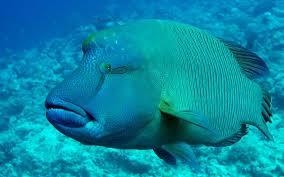
So why care about this animal? Fantastic question. As mentioned earlier, the humphead wrasse eats shellfish and other hard to eat animals, but the most notable thing that this fish eats is the dreaded crown-of-thorns starfish.
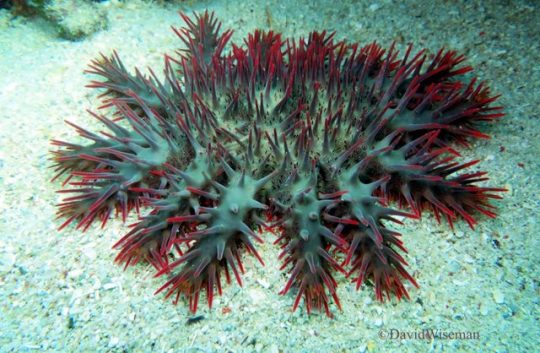
This invertebrate feeds on coral reefs, and with very few predators to prevent it from over populating, these starfish can strip entire reefs of it's coral which is vital to all life in the ocean.
The humphead wrasse is one of the few animals that can withstand the crown-of-thorns' toxins, and can keep the population in check.
But how can we help more?
You can:
Educate yourself more about the species.
Support the WWF, as they have a program that helps release humphead wrasse back into the wild.
Do not fish for this animal. If you catch it by accident, let it go.
And finally respect this amazing animal for it's majesty and power.
#Napoleonfish#Humphead wrasse#Fish#Invertebrate#Vertebrate#Zoology#Animal science#Long post#Animal Crossing#ACNH#Starfish#Coral reefs#Conservation#Environmental
7K notes
·
View notes
Text
Fish poop exposes what eats the destructive crown-of-thorns starfish
Adorned with spikes and toxins, crown-of-thorns starfish aren’t an easy meal. In fact, it’s long been thought that few animals could eat them. But an analysis of fish poop and stomach contents from dozens of Great Barrier Reef species reveals a surprising number of fish able to gulp down these prickly prey, researchers report May 18 in Scientific Reports.
That’s good news for coral reefs. Crown-of-thorns starfish (Acanthaster cf. solaris) have an appetite for living coral polyps. As they crawl over the reef, the starfish liquefy polyps with digestive enzymes, sponging up the nutrients and leaving behind a coral skeleton. Since 1962, periodic starfish population booms on the Great Barrier Reef have caused widespread coral death. By identifying which fish species can stomach a thorny diet, the new study reveals a possible way to suppress crown-of-thorns outbreaks.
Until now, the crown-of-thorns’ list of known natural predators was very short. Giant tritons (Charonia tritonis) — huge sea snails — were documented starfish slayers, injecting crown-of-thorns with venomous saliva and sanding down their spiny exterior with a rasping tongue. And while dozens of reef fish had been observed eating crown-of-thorns, most of these starfish were injured or dead.
Yet occasional starfish population booms suggest something is normally eating live, healthy crown-of-thorns and keeping their numbers in check. So to find the mystery predators, Frederieke Kroon, a biologist at the Australian Institute of Marine Science (AIMS) in Townsville, looked to the guts and feces of reef fish for answers.
“A colleague of mine at AIMS had developed the genetic marker for this crown-of-thorns species,” Kroons says, “which made me think to apply it to [fish’s] poo to identify crown-of-thorns DNA and thus potential crown-of-thorns predators.”
Over three expeditions in 2018 and 2019, Kroon and her team used nets to collect reef fish from Great Barrier Reef locations with varying degrees of ongoing crown-of-thorns outbreak. After rinsing the fish off and isolating them overnight (to prevent cross-contamination with starfish DNA in the seawater), the researchers collected the feces left behind in the fishes’ holding containers. The team also dissected gut contents from other fish collected by spearfishing. In all, the team tested nearly 700 individual fish from 101 different species.
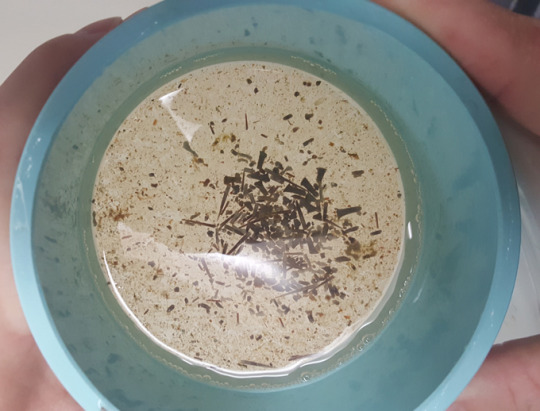
Finding crown-of-thorns starfish spines some fish poop samples (one shown) revealed to researchers that a surprising number of fish species can eat the prickly invertebrates, despite their noxious armaments.Frederieke Kroon
Genetic analysis of the poop and gut contents revealed crown-of-thorns DNA in 30 of the fish, representing at least 18 different fish species. Nine of these — like painted sweetlips (Diagramma pictum labiosum) and purple rockcod (Epinephelus cyanopodus) — had never before been identified as crown-of-thorns predators, the team reports.
“Just the fact that we found DNA of crown-of-thorns in fish poo to begin with was surprising to me! I thought we were looking for a needle in a haystack,” says Kroon. The findings suggest a greater diversity of fish may be eating the starfish than previously thought.
Kristen Dahl, a marine ecologist at the University of Florida in Gainesville, says she’s surprised even more fish didn’t turn up as starfish predators, given the breadth of species Kroon’s team sampled. Some fish may be eating only the crown-of-thorns’ tiny, squishy larvae. Compared with tough chunks of tissue torn from adult starfish, very little genetic material from these easier-to-digest tidbits would probably make it through a fish’s gut.
“Perhaps if more of these reef fish are feeding on early life stages, the DNA degradation would be quicker or more complete,” says Dahl, “leading to reduced ability to detect predation” in poop samples.
youtube
A blackspotted puffer (Arothron nigropunctatus) feeds on a crown-of-thorns starfish in the laboratory, nipping at it with its strong beak. This species was previously known to eat crown-of-thorns. But a new study looking for starfish DNA in fish poop and guts revealed at least nine previously unknown species that are also crown-of-thorns predators.
Delving into the diets of reef fishes can help scientists better understand how species interact and how nutrients flow through coral reef food webs, says Jordan Casey, a marine biologist at École Pratique des Hautes Études in Perpignan, France. “This is an especially important puzzle to solve nowadays, under the growing impacts of climate change,” she adds, which threatens reefs worldwide.
Understanding ecological relationships has unveiled other useful allies in the effort to preserve reefs, like algae that protect corals from hungry starfish (SN: 8/28/15). Likewise, figuring out who’s eating whom may be key to dampening future crown-of-thorns outbreaks. Current methods to control outbreaks involve killing individual starfish, says Kroon. Her team’s findings could inspire new approaches, such as providing refuges and fishing protections for species that can control these spiny reef-eaters.
from Tips By Frank https://www.sciencenews.org/article/fish-poop-exposes-what-eats-destructive-crown-thorns-starfish
0 notes
Text
Pokémon in our Biomes pt. 20: Coral Reefs (2 of 2)
“I’ve recently decided to make a series of posts with hypothetical thinking and analyzing of what Pokémon species could potentially be found in the world’s biomes. Not at all relative to the games, I will be focusing primarily of the elements, design, and relativity to real life flora and fauna of Pokémon to depict where different species would roam on our big blue marble.”
This is the first biome post that I have made in over a year, so I’m really excited for this post! I’m sorry for the inactivity, but I’m back, so here we go!
This is actually the second coral reefs post, and you can find the first one here, and that post was uploaded two years ago today! In the last post, I had mentioned how there are four main types of coral reefs: fringing, barrier, atolls, and patch reefs. Since this is my first post since Sun and Moon was released I am going to try to focus my analysis more on the fringing coral reefs around Hawaii, the region that Alola is based off of.


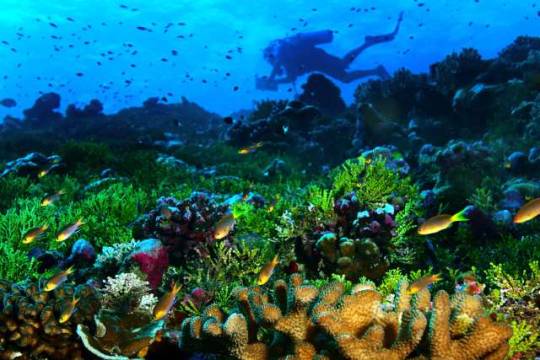
The Hawaiian coral reefs stretch for 2000 km, and account for more than 85% of the reef systems in the United States. With more than a quarter of all of the fish, plant, and invertebrate species in the Hawaiian coral reefs being endemic to Hawaii, there is a huge diversity of life that can’t be found anywhere else. This may explain the unusual designs that many Alolan Pokémon have, and maybe I can shed some light on how their morphological and anatomical traits have evolved to help them in Alola, like so many species in Hawaii have traits that help them survive.
Let’s get started!
Staryu
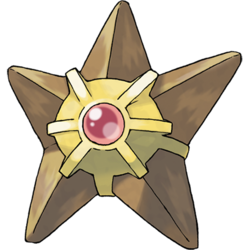
Staryu is a starfish, which is a member of the echinoderm family. As you will see throughout this post, many species of Pokémon are echinoderms. Echinderms are pretty amazing, as their unusual but very primal anatomy allowed them to evolve to be the second-largest grouping of a superphylum, right after chordata in the world. Staryu is like many starfish in that it has remarkable regenerative abilities. Most starfish in the real world cannot “regenerate” from severed limbs, creating two beings or clones, so most of the Pokédex entries that say they retain the ability to regenerate from thousands of pieces as long as their core remains intact is a bit of a stretch. Staryu, like most other starfish, are diverse in their locations throughout the ocean. Perhaps species more adapted to deeper water can be found in the abyssal zone where they can evolve to Starmie.
Pyukumuku
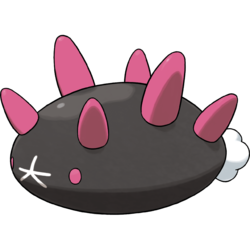
Like Staryu, Pyukumuku is a sea cucumber, which is an echinoderm. Echinoderms have an endoskeleton which helps form their shape and adds some form of rigidity to their body. Pyukumuku, like many species of sea cucumber in real life, can excrete a white sticky substance used in self defense. However, Pyukumuku have more control over these excrements as they are the internal organs of the animal. Most wild sea cucumbers that have this ability release the sticky filaments in a random way and the animal doesn’t really have any control over the movement of these filaments. Like Staryu, Pyukumuku would feed on the detritus of other animals off the bottom of the ocean floor.
Finneon

I didn’t really go over this too much in the last Coral Reefs post, but many fish species in reef environments essentially have one of two shapes: very tall with short bodies to allow for very sharp turns among the coral, or have amazing fin designs that are used to attract mates or deter prey. Luvdisc is a great example of this trait as it can be easily related to many species of angel fish or other reef fish, but Finneon is a bit different. Finneon have unique fins that I believe would not allow for speed through the water, so it makes sense that the dual-tail fin would only aid in quick maneuverability through the cracks in reefs.
The ability to absorb light in the lines along its body may help it confuse predators at night. It would sort of dazzle predators in a way similar to how zebras have their stripes to blend themselves together to seem like a giant mass of zebra. Finneon may operate their schools in a similar way, confusing any predators that would try to pick off individual Finneon from a school. This may be a pretty effective means of defense as most predation in coral reefs occurs at night. The dazzling light show may really confuse potential predators, and should any Finneon get isolated from the school and chased down, their best course of action may be as simple as turning off the lights.
Mareanie/Toxapex


Although when I first saw these two Pokémon I truly thought that they were designed to look more like sea urchins than the crown-of-thorns sea star, however when I finally learnt more about its prey item, Corsola, it made sense. Coral is incredibly difficult to utilize as a food source because there really isn’t much to coral. Coral is essentially layers upon layers of calcium carbonate, or chalk. It is difficult to use this as a food source as there is no protein, or other vital nutrients.
However, a few animals have adapted to utilize the calcium carbonate as a fuel source, and crown-of-thorns sea stars are so environmentally catastrophic (on top of coral reefs being destroyed by humans) conservationists have begun fencing off areas of coral reefs in efforts to protect them.
I imagine that in the Pokémon world, the problem with Mareanie and Toxapex is quite similar to the conservational problems that the crown-of-thorns sea stars are giving in our world. I can assume that although Mareanie and Toxapex are quite dangerous, if they are in fact like the crown-of-thorns sea star, their skin is very fragile and their bodies are actually quite gelatinous. If the sea star is brought onto land from the ocean, the membrane is likely to break, releasing the inner fluid that provides the animal with its shape. This even renders the venomous spines useless as they don’t retain enough rigidity to pierce skin at this point.
Bruxish
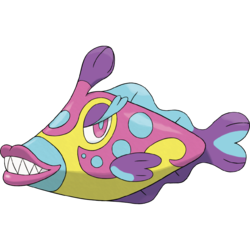
Shockingly enough, Bruxish uses the appendage on its head to emit psychokinetic waves, and not light. This Pokémon resembles a number of reef fish species, like trigger fish, parrot fish, and butterfly fish. The colourful pattern of Bruxish may help to ward off predators and warn them of Bruxish’s powerful telekinetic powers.
Apparently Alolan lifeguards allow Bruxish to swim near beaches and popular tourist spots as it drives potentially dangerous Pokémon away with not only its telekinetic powers, but also its amazingly strong jaw, which not even Shellder are safe from. Unfortunately, there isn’t necessarily any compelling evidence that it feasts on Mareanie or Toxapex other than its distinct type advantage. If anything, its strong jaw allows it to indulge itself on tougher Pokémon, like Corsola.
Thank you for reading!
Hopefully for my first post in over a year this was as much fun for you guys to read as it was for me to write. I belief this is going to be the first in many new posts! Furthermore, I plan to continue extending previous biome posts to cover more Pokémon.
As always let me know what you thought, if you have any recommendations, insight, opinions, etc. Please don’t take credit for my work.
#pokemon#pokemon science#pokemon biology#pokemon in our biomes#pokemon in real life#alola#alola pokemon#coral reef pokemon#finneon#mareanie#toxapex#bruxish#pyukumuku#staryu#mewistheancestor
239 notes
·
View notes
Video
"The Real Harlequin . . . Shrimp" - 🔵@maestro320 's Notes: I'm pretty sure three fouths of the world population got to see Suicide Squad, and who wouldnt forget Margot Robbie's @margotrobbie colourful portrayal of Harley Quinn (Dr. Harleen Frances Quinzel)? • A Harlequin would refer to a mute character in traditional pantomime, typically masked and dressed in a diamond-patterned costume. And out in the ocean, we have just that, a real-life Harlequin filmed on location in Tulamben, Indonesia courtesy of 📽️ Dustin Adamson and 📸 Tyra Adamson at Oceanshutter @oceanshutter - Have you ever seen a Harlequin Shrimp feasting on a star fish? We saw this one in Bali in Tulamben. Lots of time they will chew off a leg. Good thing star fish can grow them back. • Hymenocera picta, commonly known as the Harlequin Shrimp, is a species of saltwater shrimp found at coral reefs in the tropical Indian and Pacific oceans. It is usually considered the only species in the genus Hymenocera, but some split it into two species: H. picta from the central and east Pacific where the spots are deep pinkish-purple with a yellow edge, and H. elegans from the Indian Ocean and west Pacific where the spots are more brownish and have a blue edge. They reach about 5 centimetres (2.0 in) in length, live in pairs and feed exclusively on starfish, including crown-of-thorns starfish. It does seem to prefer smaller, more sedentary starfish, but as these generally are not sufficiently numerous for its needs, it commonly will attack Acanthaster, both reducing its consumption of coral while under attack, and killing it within a few days. The Harlequin moves at a very slow pace and in waves. It also may have toxins from its prey (the starfish) which could make it distasteful and potentially dangerous for predators. The shrimp also moves its claws almost constantly. When it comes to males and females, the females are larger and have colored abdominal plates unlike the males. "The female produces between 100 to 5,000 eggs per season depending on environmental factors." The male and female are often seen together in the wild and work together to not only reproduce but also eat food. https://www.instagram.com/p/B2duTlnjYa5/?igshid=1ti9cpjwnaorb
0 notes